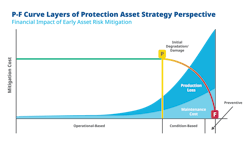How integrated asset health systems improve plant reliability and reduce costs
There are many good reasons plant personnel of every category want to avoid unplanned outages. Most obviously, stopping production results in lost revenue, whether the stoppage lasts hours, days, or months. Many other unnecessary costs stem from unplanned outages. Personnel often must work longer and harder to bring the plant online after an equipment failure, which can mean overtime or hiring extra personnel to complete the necessary maintenance or repairs. Teams also frequently find that they do not have necessary parts, tools, or heavy equipment on hand to perform an unexpected repair, which can result in costly fees to expedite delivery of necessary implements.
Even though the cost of unplanned outages is a serious concern, the more serious potential consequence of unplanned shutdowns is compromised safety. Unplanned outages are often rushed outages and rushed personnel do not operate at their best. Moreover, as organizations continue to commit to more sustainable operations, unexpected failures can significantly hinder net zero initiatives, from the impact of spills to the increased emissions that come as a result of expediting parts and equipment.
Fortunately, modern automation provides many solutions to help plant personnel stay ahead of equipment failures. Predictive and preventive maintenance technologies provide reliability teams the tools they need to stay on top of asset health and intervene well before shutdown is imminent. This article outlines how today’s forward-thinking teams are implementing comprehensive, integrated asset health systems that save time, improve production, and reduce downtime. These teams build a reliability infrastructure that gives visibility to all their assets and prioritizes seamless connectivity to turn information into insights using a variety of analytics tools.
Building a data foundation
Implementing a comprehensive, integrated asset health system starts with building a foundation of instrumentation and software to support data access and mobility. Today’s reliability teams are often small and must operate nimbly to accomplish all their goals. As a result, many plants find themselves with a conundrum: skilled personnel—including highly-skilled data scientists—are relegated to the low-value task of collecting data. Each minute spent walking around the plant to view assets individually is a minute that person could have spent improving performance, implementing reliability strategies, or even building the intricate data models that lead to better insights and decision making. Teams hoping to stay ahead of failures need better, less-time consuming visibility into plant and asset health.
At the asset level, unlocking visibility means fitting machinery with modern solutions to provide continuous insight into health and performance. Modern wireless vibration monitors are a cost-effective way to collect data on rotating equipment 24x7, 365 days a week. To further increase visibility, those same solutions can be coupled with edge analytics devices that not only monitor vibration, but can also include additional variables such as pressure, temperature, flow, and more. Edge analytics devices then apply that data to built-in analytics to instantly identify some of the most common problems with rotating machinery.
Next, bringing the data from monitoring solutions into a fit-for-purpose, integrated asset management platform helps teams identify asset problems and their solutions even quicker. For example, device management applications use open standards and protocols to bring a wide range of devices together to provide real-time, online access to intelligent instrument and valve diagnostics and alerts. Technicians using the best device management software solutions can see real-time condition data and respond quickly to issues and make informed decisions.
Device management software also can be coupled with machinery health software for even more visibility into asset health. Machinery health software brings data collected from machinery into a single location to quickly and intuitively identify bad actors among a plant’s assets. Combining predictive maintenance techniques with comprehensive analysis tools, machinery health software makes it far faster and easier to make sense of the data coming in from sensors.
Building comprehensive visibility
Once an organization has a suite of integrated instrumentation and software in place to continuously collect asset health data and actionable information, it needs a way to easily bring that data into a single pane of glass, and to push alerts and information out to key users wherever they may be. Reliability teams accomplish this visibility with enterprise-level reliability software designed to seamlessly integrate with their asset management tools. Using data collected from device management software, machinery health software, historized data and more, enterprise level reliability software applies layers of built-in analytics to turn raw data into intuitive, actionable advice—all available on a single dashboard from anywhere across the enterprise.
Users can quickly glance at a single dashboard to identify which assets across the enterprise need immediate attention. With only a couple of clicks, they can drill down into asset health details to see what triggered a low health score and receive guidance for the next actions to take. They can even create maintenance requests in the computerized maintenance management system (CMMS) or enterprise asset management (EAM) system right from the dashboard, auto-populating sensor readings and recommendations to streamline the maintenance process.
Increasing performance with advanced analytics
The best enterprise-level reliability software solutions can be seamlessly integrated with predictive and prescriptive asset health software to form a comprehensive asset health system. This software relies on a variety of agents to make advanced analytics intuitive enough that maintenance and reliability personnel can confidently navigate it out of the box, while also providing the flexibility for data analysts to bring their own insights and models into the system.
Agent-based analytics capabilities bring asset health information together with process data for the most clarity into the health of a plant, or multiple plants across the enterprise. For example:
- Rule-based agents: Best for simple monitoring, rule-based agents monitor sensor and calculated sensor data in real time to trigger alerts when data points are out of bounds.
- First principle-based agents: Best for identifying asset degradation, first principle-based agents use physics-based calculations (e.g., following the pump efficiency curve) to assess asset degradation based on pre-defined criteria.
- AI and machine learning-based agents: Best for predicting degradation, AI and machine learning-based agents use pattern recognition algorithms that incorporate multivariate data to predict asset degradation based on embedded domain knowledge.
In the best predictive and prescriptive asset health software, configuration is simple enough that users with domain knowledge can install, configure, and begin running their analytics in a matter of days. If the software integrates seamlessly with data collection and basic analytics tools, users simply need to point the advanced analytics software at the correct variables in the organization’s historian, and the agents will have everything they need to begin advanced analysis.
Advanced analytics in action
Every piece of the analytics puzzle, from data to collection, to analysis at the source, to multivariate, agent-based advanced analytics, is critical to identifying problems as early as possible and intervening before issues become failures that shut down a plant or process. While every piece of data is valuable—even in a vacuum—reliability tools offer the best predictive and prescriptive advantages when they are all used together to form a holistic picture of plant and process health.
Consider a compressor experiencing multiple problems. A wireless vibration monitor might identify excessive vibration and alert the machinery health software. Simultaneously, a process sensor might identify a problem with discharge pressure while others identify high suction temperatures and high bearing temperatures, feeding that information into device management software. Each of these variables may be a low consequence on its own. However, when examined together through the lens of agent-based multivariate analysis fed by historical data and a wide library of failure modes and effects, they can paint a clearer picture of a serious impending problem well in advance of failure. Using pattern recognition, advanced analytics can identify those individual readings as part of a larger, more serious problem that has shut the plant down in the past and will notify users so they can take action during the next planned outage (Figure 1).
Accomplishing such complex analysis is difficult if all the variables are siloed in disparate systems, and must be examined individually. However, if intelligent field devices feed seamlessly into industrial software solutions at the edge, which themselves feed into enterprise-level reliability software powered by integrated predictive and prescriptive analytics software, every piece of data contributes to helping teams identify potential problems before they cause any equipment degradation. Teams can receive real-time alerts to their mobile devices and collaborate more easily with single-click generation of work orders in the CMMS or EAM (Figure 2).
Drive competitive advantage
In coming years, competition among industrial manufacturers will only increase, and unexpected downtime is anathema to competitive advantage. Reliability teams, and even data analysts, will need access to powerful analytics tools to intervene before process and asset problems cause failures that lead to unanticipated outages. While there are many ways to accomplish all the steps to predictive and prescriptive maintenance, only a technology stack designed for seamless integration will do so quickly and with the low complexity and overhead necessary to provide value to today’s lean reliability and data analytics teams.
About the Author
Doug Cooper
Doug Cooper is a Product Management Director for AspenTech with more than 20 years in reliability and operations. Doug received a bachelor’s degree in mechanical engineering from Texas A&M University and an MBA from the University of Houston, Clear Lake.
Greg Rome
Greg Rome is a Product Manager for Emerson’s Reliability Services group with nearly 30 years in the automation industry. Greg received a bachelor’s and master’s degree in electrical and software engineering, respectively, from the University of Minnesota.


